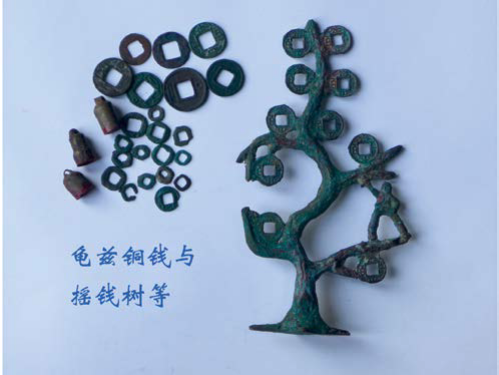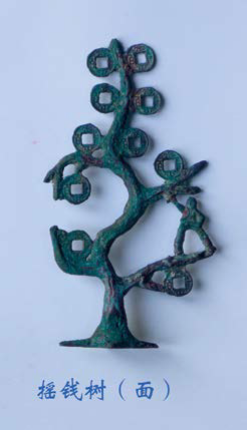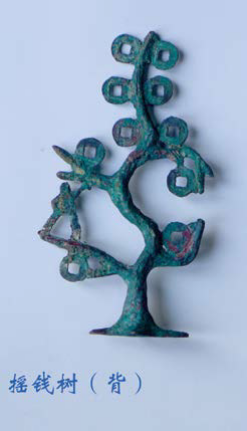Chinese money trees were first discovered and unearthed in the Central Plain of China. A total of 189 money trees have been found in China so far, mainly in Sichuan, Chongqing, Yunnan, Guizhou, Shenxi, Gansu, Qinghai, Ningxia, and Hubei. In 2015, a money tree was discovered and unearthed in Xinjiang Province for the first time. Cultural relic experts and numismatists divide the money tree history into three periods: early, late Eastern Han dynasty and the Shu-Han period. The money trees symbolized people’s pursuit of wealth and longevity. However, money trees had not been found in Xinjiang Province before, so the research on this subject in this region is still inadequate. To understand the importance of the discovery of the first money tree in Xinjiang Province we should examine the origin, function, and cultural symbolizations of money trees by referring to the research by Ji Xianlin, Xiao Qing, He Zhiguo, Zhong Zhi, Xiu Shuzhong, Tang Guangxiao as well as the documentary film titled “Research on Chinese Money Trees” produced by CCTV Discovery Channel.
I The Origin of Money Trees and their Regional Distributions
There are two legends about the origin of the money tree: one is that the money tree originated from the bronze trees of the Shang dynasty that were unearthed in Sanxingdui, Sichuan Province; the other hypothesizes that the prototype is the ‘tree lamp’s with multiple branches which was popular in the Warring States period or the various models of ‘holy trees’. Most scholars support the latter viewpoint at present. Some scholars even conjecture that the animal and coin patterns on the branches of the money trees may be closely related to bronze branches that were unearthed in Yanyuan county, Sichuan Province.
As early as in the Eastern Han dynasty, money trees began to appear in very small quantities, mostly in the Chengdu Plain. Later in the middle and late period of the Eastern Han dynasty the money trees became very popular in the area covering modern Sichuan, Chongqing and their surroundings. From the end of the Eastern Han dynasty to the Three Kingdoms period, the quantity of money trees rapidly dwindled and they eventually vanished during the Western Jin. Money trees, which are usually unearthed in large and middle[1]sized graves, belonged to wealthy families.
II Function and Background of the Origin
There are three viewpoints about the function of money trees. First, they were used for sacrifices to ancestors; second, they were regarded as early Taoist trappings; or third, they were special burial wares.
The third is regarded as the most likely theory based on the evidence in academic circles and, in fact, money trees likely have various uses: a guide for the deceased to Heaven, or to pursue wealth or shelter for the descendants of the dead.
After many years of research, scholars and experts have concluded that the money trees originated from the ancient people’s worship of trees. The worship of trees was a common cultural phenomenon in ancient China, especially in the Ba-Shu Region. People worshiped two holy trees “Jianmu” and “Ruomu” which were regarded as the ladder for Gods to go to Heaven and to the home of the Sun God. So the patterns of leaves in many early money trees were combined with legends of different regions which later evolved into the carved patterns of pillars and Tree God. ”
“The main tree structure with regional patterns is like a God with a tree on his head. The worship of “Jianmu” and “Ruomu” persisted through the Xia, Shang, Zhou, Qin and Han dynasties and changed as time passed.” In the Han dynasty, people gained a more humanistic perception and some religious concepts slowly faded. The various mythic patterns on the tree leaves were replaced by carved coin patterns. This change implied that people’s worship of gods altered to worship money and wealth. In the Qin and Han dynasties, the money trees were used as the lamps which reminded people of the tree of the Sun God who brought light for people on earth, or became the symbol of land and money.
III Cultural Symbolizations
As to the cultural property, most people consider money trees a cultural relic of southwestern China, because they were only found in this region. But others proposed in the 1990s that the money trees were a cultural achievement of the Han dynasty and the users were the Hans migrating to the Chengdu Plain. The evidence for this is found in graves from the period from which money trees have been unearthed. The layout, scope and burial items of these graves were similar with those in the Central Plain, but very different from those in the southwest region.
IV Structure and Layout of the Money Tree
Money trees contain two parts: the base, which was made of pottery or stone, and the bronze tree, which was inserted into the base. The tree has a trunk and leaves. In the earliest money tree period, the trunk was solid, but most of the unearthed trees are hollow. The trunk generally was 1.5-2.0 meters in length and in 4-6 segments. There are 4 slots in each segment for inserting the branches. The decorations on the tree include various patterns such as phoenixes, the Queen Mother of the West, dragons, feathered fairies, monkeys, and coins.
V The First Discovered Money Tree in Xinjiang Province
On 1st January 2015, Chu Huaizhen, a member of the Chinese Cultural Relics Society and the China Numismatic Society bought some coins of the ancient Qiuci Kingdom and a money tree from a man who came from Qiuzi [the old Chinese transcription for the Tokharian name of the old kingdom of Kucha, now a part of Aksu]. Rust was attached to the surface of the coins on the tree and the color of the rust near the inscriptions looked natural. The inscriptions on the coins “Ting Ping Yi Pai” of the money tree looked very beautiful and were clearly written in firm strokes. The inner line of the hole of the coin was smooth. It is a rare item which has been authenticated by many numismatic experts and scholars.

The seller told us that this freshly unearthed bronze money tree with 10 “Ding Ping Yi Bai” coins was unearthed with other coins from the ancient Qiuzi Kingdom. According to the Illustrated Catalog of Ancient Chinese Coins written by Ting Fu-pao: “There’s no doubt that the ‘Ding Ping Yi Bai’ was made in the period of Shu Jin ( 蜀 晋 ) because they were also made as the small ‘Chih Pai’ and ‘Han Hsing’ coins. In addition, all of them were unearthed in Sichuan. Only who struck these coins is still unknown.”
The editor of China’s Cultural Relics noted that “Ding Ping Yi Bai” was one type of Chinese ancient coins, mostly unearthed in Sichuan, but was also unearthed together with a “Tai Ping Yi Pai” in Dantu, Jiangsu Province. A History of China’s Coinage written by Peng Hsin-wei commented that “Ding Ping Yi Bai” was minted in the late Shu Kingdom period. The coin is thin, and there are large and small varieties of these coins. The large variety is 16mm in diameter and weighs 1g, while the small variety is 12mm in diameter and weighs 0.6g. The seal inscriptions cannot be recognized clearly and read vertically. All of coins have a plain reverse. The accurate attribution of these coins remains to be further researched.


VI Research on the Money Tree unearthed in Xinjiang
This money tree has 10 coins and weighs 180g. It is 180mm in height. Besides these 10 coins (the Qiuzi characters at the top and bottom of the coins respectively, and the Chinese characters “Wu” and “Chu” on the left and right respectively on the reverse), there is also a small bronze figure to the right of the tree. The figure looks towards the right, with his hair in a bun, the hair line on the forehead and the two sides can be clearly seen. His face is smooth, and he wears a coat with a round collar and tight sleeves. His left hand is clenched in a fist grasping his clothing while his right hand shakes the tree. It seems very delicate.
It has been verified by experts who state that the figures in southwestern money trees, except for particular Buddhist trees, always had a handlebar mustache characteristic of the nomadic people of that time. So that among the celadon figurines with handlebar mustaches of the Kingdom of Wu, unearthed at the E-Gang beverage factory (in Ezhou, Hubei province), the figurines with a peaked cap were related to Buddhism because they combined the Buddhist portraits with handlebar mustaches and that of the northern barbarian tribes in ancient China who usually had peaked caps.
What is more, the Buddhist portraits on the money trees which were unearthed in southwest China were one of the earliest portraits of China, related to the time and the route of the early portrait transfer from India to China. So the timing of these coins is particularly interesting to the academic world. One question remains: was the portrait on the money tree which was unearthed in Xinjiang related to Silk Road culture and religion? Was the figure a Buddhist portrait or was it one of the Han or northern barbarian tribes? More research is needed before we can answer these questions.
Conclusion
The money tree was also called a sacred tree. It became popular in southwest and southeast of China in the period of the Eastern Han dynasty. The coins had the scripts “Ting Ping Yi Pai” on the obverse, and Qiuci scripts at the top and bottom on reverse, with Chinese characters “Wu” on the left, and “Chu” on the right on the reverse. These newly found Qiuci coins and money tree entered into the ancient western regions after the “Ting Ping Yi Pai” (306AD to 310AD) was minted. The later minted money tree and the “Ting Ping Yi Pai” with script “Han Qiu Wu Zhu Qian Bi” are evidence of the folklore faith of the people in the Bashu region and of Qiuci culture. Even more, they were the creation and typical representative of the culture of ancient Xinjiang [and Chinese] numismatics. From another aspect, Chinese numismatic culture and the art of casting are fully reflected in this money tree. That the money tree appeared in Xinjiang fills a blank in the field of Xinjiang numismatics. It would worthwhile to research how the money tree entered into the ancient western region and by whose hand? Were the money trees from the ancient western region or from China’s Central Plain? Further research is needed before we can answer these questions.
